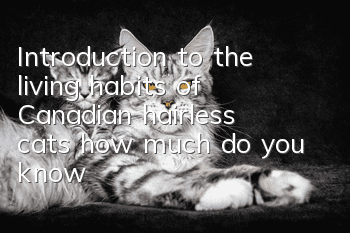Introduction to the living habits of Canadian hairless cats, how much do you know?

Canadian hairless cat Hairless), also known as the Sphynx cat, was bred by cat lovers in Toronto, Ontario, Canada in 1966 from a litter of almost hairless cats through inbreeding and selection, specifically for cats allergic to cat hair. nurtured by the benefactors. This kind of cat is a pet cat produced by a natural genetic mutation. Except for some thin and soft lanugo hair on the ears, mouth, nose, tail front, feet and other parts, the rest of the body is hairless, and the skin is wrinkled and elastic. Canadian hairless cats are docile, independent, non-aggressive and can get along with other cats and dogs. How much do you know about the living habits of Canadian hairless cats?
Canadian hairless cats (detailed introduction)
Canadian hairless cats love to lick their bodies to clean themselves and clean themselves frequently. own hair. After meals, it will wipe its beard with its front paws, lick its anus with its tongue after urinating, and lick its fur with its tongue after being held. This is the little hairless cat removing odor and dirt from its body. There are many rough little protrusions on the tongue of hairless cats, which are tools for removing dirt. Hairless cats lick their coat with their tongues to stimulate the secretion of sebaceous glands, making the coat shiny and lubricated, making it less likely to get wet with water, and licking up a small amount of vitamin D, which promotes the normal development of bones and makes the coat fluffy. Promote heat dissipation function. Hairless cats usually start grooming and grooming their coat after eating and playing, or after vigorous pursuit of prey, or after waking up in the sun. During hot seasons or after strenuous exercise, a large amount of heat is generated in the body. In order to maintain a constant body temperature, excess heat energy must be discharged from the body. Therefore, hairless cats use their tongues to smear saliva on their coat. The evaporation of water in the saliva can take away heat and play a role in cooling down and relieving heat. Frequent combing during hair removal can promote new hair growth. In addition, by scratching and biting, you can prevent the coat from being infected with parasitic diseases, such as fleas, lice, etc., and keep your body healthy.
The behavior of hairless cats covering their feces is completely out of life instinct and is inherited from their ancestors. The ancestor of the hairless cat, the wild hairless cat, covered up its feces in order to prevent natural enemies from detecting and tracking it through the smell of its feces. This behavior of modern hairless cats no longer makes any sense in this regard, but it has given hairless cats a good reputation for hygiene.
All cats have excellent day and night vision capabilities, so Canadian hairless cats are no exception. Hairless cats still maintain the nocturnal habit of carnivores, and many activities (such as mouse hunting, courtship and mating) are often performed at night. [5] Hairless cats are most active every day at dawn or dusk, and spend most of the day lazily resting or sleeping. In bright places, hairless cats will shrink their pupils as narrow as a line to reduce damage to the retina, but this will limit the breadth of the field of vision. There is a blue-green fluorescent film (called tapetumlucidum) on the back of the omentum of hairless cats, which can increase vision in dark places. In the flash, hairless cats' eyes can appear in various colors. Like most carnivores, their eyes are pointed forward on their faces, giving them a wide field of vision.Hairless cats have poor ability to distinguish the three primary colors. If Canadian hairless cats only have dim light here, they will use their whiskers to improve mobility and perception. Beards can sense very weak winds to identify obstructions without being able to see them. Hairless cats have three eyelids. When the hairless cat's eyelids are open, the pierced eyelids will slightly cover the eyes from the side. If the hairless cat is sick, sleeping or laughing, this eyelid will retract part of it. If a hairless cat has its third eyelid exposed for a long time, it is a sign of illness.
Almost all hairless cats usually have ears pointing upward. Unlike dogs, hairless cats with folded ears are very rare. The Scottish Fold Hairless Cat is an example of a genetic mutation. When angry or frightened, hairless cats will droop their ears and make a growling sound. When listening to something, the hairless cat will move its ears so that the hairless cat's ears can hear sounds from multiple directions.
In addition, Sphynx cats have an honest temperament, great tolerance, and good tempers. In some ways, they are more like dogs, easy to get close to people and loyal to their owners.
Compared with other cats, it sweats more and its body temperature is 4℃ higher than that of ordinary cats. Therefore, it needs to eat continuously to maintain its metabolism. This is a cat that is very sensitive to sunlight. Because they are hairless, they have poor ability to regulate external temperature. They are afraid of both cold and heat, because their white parts are prone to tanning. When the room temperature is maintained between 25 and 30 degrees, this cat will feel very comfortable. If the temperature is below 20 degrees, it will feel cold. If the indoor temperature is below 10 degrees, the hairless cat will freeze to death. . This cat is suitable for apartment keeping. In summer, owners need to apply sunscreen to them to avoid sunburn; in winter, they need to add clothing to cover themselves and keep warm.
- What does a cat’s frequent purring mean?
- What causes blood in cats’ urine?
- What to do if a cat suffers from colibacillosis
- How to guide a cat to poop in the cat litter?
- How should a cat drink water with an Elizabethan ring?
- If a pregnant kitten keeps meowing, is she about to give birth?
- How to save a dying kitten from the cold
- Treatment methods and precautions for ringworm in pet cats
- Does a cat hold a grudge after being beaten?
- The appearance characteristics and naming principles of Shandong Lion Cat



